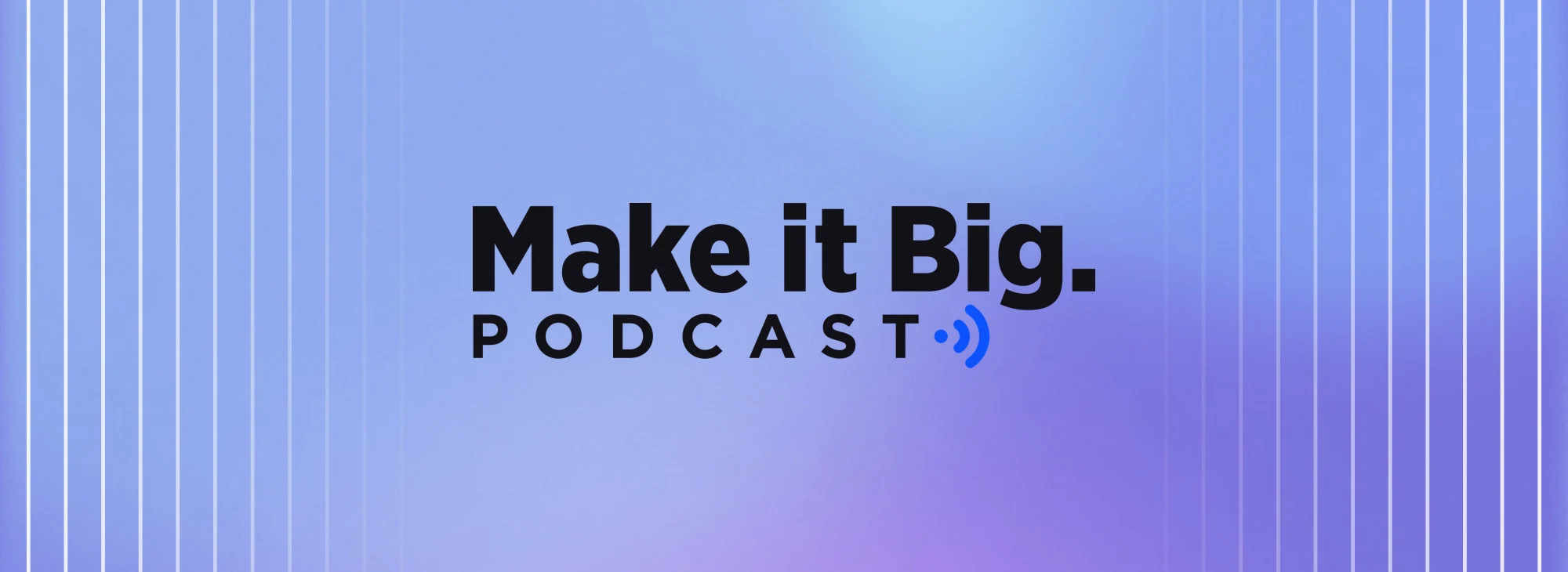
Ecommerce insights on the go
Tune in to the Make it Big Podcast — our thought leadership audio series for retailers, entrepreneurs and ecommerce professionals. You'll get expert insights, strategies and tactics to help grow your business.

Make it Big Podcast: How to Approach Global Expansion with Digital River and Americaneagle.com

Welcome to The Make it Big Podcast, a bi-weekly audio series about all things ecommerce by BigCommerce.
We’re talking about global expansion. Join us as BigCommerce Vice President of Product Marketing Meghan Stabler discusses cross-border selling strategies with Ted Rogers, Chief Revenue Officer of Digital River, and Pierre D’Arbost, General Manager for EMEA at Americaneagle.com.
All episodes of The Make it Big Podcast are now available on Spotify, Apple and Google.
The Make it Big Podcast: Episode 23
Meghan Stabler: This is a hyper competitive market, right? We talked about the necessity of looking at what your competition is doing as you look into these markets. So what are the keys to long-term success through these growing pains? What should you be looking at as that balance between taxing your team, putting stress on established processes? How do you look at it?
Pierre D’Arbost: “Yeah, that’s a good question. I think operational efficiency needs to match growth to support margin. You need to figure out what generic website and fulfillment processes can be employed versus country specific. You have to be quick off the march in identifying operation issues and resolving them. I mean, I think from an ecommerce platform perspective, BigCommerce’s multi-store front, helps optimize website operations on the front end and back end. So I think again, selecting the right tech stack to support your international growth will help you react to these challenges.
“And then in addition to that, I mean, ultimately you want to be growing your turnover. So I think regularly reviewing, optimizing the customer experience for new or repeat customers, including if you have customer acquisition channels, I think that’s really important. And your product mix and aligning what are the value adds that appeal to those target customers in those specific countries? Some countries expect free shipping, others don’t. So I think from an operational point of view it is, zero in operational efficiency but be aware of the cultural differences that you need to maintain.”
MS: Let’s keep that conversation then going around cultural concerns, right? It’s always obvious to me when somebody gets it right, because I can see myself in the imagery, the personalization they’re bringing forward. And we have to think, when you’re doing cross-border, I may be selling into an Indonesian market, but I don’t want to use just white person imagery or the way that I may like to have salutations. And I think, Pierre, you and I both coming from Europe, we know that with formal and informal emails and letters that go to somebody who’s in Holland is different to somebody who’s in France, is different to somebody who’s in the UK and is completely different to somebody who’s in the US that just says, “Hi, Pierre, how you doing?” You’re not going to have that in an email going into the UK.
So let’s get into the cultural concerns, right? Because I think any aspect of business that crosses borders has to be conscious of things like cultural sensitivities, local traditions, the regional specific omnichannels that I mentioned before that are in there. So this is sort of an open question for both of you. How do you make sure you’re doing the right thing by the various locales in which you are selling into? Who wants to pick that one up first?
Ted Rogers: “One of the things that we did last year, we conducted a study with payments.com, and it was all about the cross-border friction index. What was the consumer experience like? What are their expectations when they’re looking to purchase online? And we did it both from a local perspective, but really trying to understand the implications through the eyes of the consumer for cross-border. Where the inventory is in a different country and having it ship to the country where the consumer’s at.
“So it was kind of a ranking, pretty straightforward based upon a whole bunch of factors. We kind of built this score, this index. And for the brands that were at the top… And this may seem very basic, and to some folks that are listening and certainly to the folks on this call, but 75% of the top brands that we saw were using some form of IP geo detection to basically use everything that they could to understand where the consumer’s at and then localize that experience.
“And oftentimes from a Digital River perspective, we talk localization. And that’s usually localization of the payments, currency, making sure you’re collecting tax the right way and assessing fraud based upon what we know about that market. But the first parts of those mean something to the consumer, the real back office things that they don’t even get, the fraud aspects, the consumer doesn’t really care about. But what the consumer does care about is understanding where they’re at to do what you can to get that experience in the right language.
“And like you talk about the imagery. Even down to the catalog, because you can’t necessarily ship every product to every country. Especially when you get into this cross-border commerce, you have to make sure you know that you can sell your product there. So making sure your catalog represents the products that they can actually purchase, can be delivered to them within the bounds and the rules and regulations of international commerce.
“So that’s one of the main things that we saw, which was a shift for the consumer, was really more about having that real local experience, like you talked about, Meghan, where years ago it used to be about speed of transaction. Now speed of transaction is an expectation, that I’m going to be able to get the things, get through the process, get what I want and complete that transaction quickly. That’s not a laborious process. It’s really about that experience and does it match my cultural expectations?”
MS: Pierre, what are we missing from that part of the conversation? What else do you have to consider?
PD: “I think that if you’re going to embark on an international sort of expansion, I think start with market research. I mean, there are the basics that Ted covered in terms of, what’s the lowest inhibitor endpoint in terms of entry? English speaking, so on. But yeah, I mean, no matter what home country you are operating from your government will have an international trade office. Okay? And in the UK, for example, there’s a really good government department office called the UK Trade and Industry Department. And they execute a program that helps companies export. And within that particular program you can get access to market intelligence resources and reports and so on.
“And then adding to that, you’ve then got the independent service providers. Again, from a UK perspective you’ve got Internet Retailer. And these guys produce RetailX reports by industry, by country. You can review those to identify product and service gaps, opportunities upon which to launch your brand and products. And then one of the other things, I mean, obviously I work for an American company and we’ve been reviewing an organization called AmCham, which is American Chamber of Commerce, who has a presence around the world. And those guys do have European offices, offices in the Gulf. And they’ve got a lot of information and resources that can help you get the basics in terms of, ‘How do I localize my brand and offering to serve this country?’
“Once you’ve got that information you’ve got to sit down and you’ve got to say to yourself, ‘Okay, well what are my cultural differences in my home market versus the country I’m looking to launch into?’ And identify those differences. For example, if you are selling beverages online, perhaps selling a new alcoholic cocktail to countries in the GCC isn’t going to go down well. But if you happen to be in the European and American sports car parts business, it will go down very well.
“Meghan alluded earlier that sort of looking at how people engage digitally… I think certainly many countries, especially in the far east, mobile just kills desktop. And so you’ve got to think about, how are these people engaging digitally with your brand?
“So in summarizing, I think determine your country localization strategy, look at your products, look at your content, will it work? And if you think it’s a go then localize the payments, the taxes, the shipping, the returns. Also check to see if your planned promotions and discounts will apply culturally, because again, some countries it doesn’t resonate. If you apply some form of discount it may seem that actually it’s a cheap product or something like that. So be wary of all of that. But if you look at all those aspects you’ll connect the dots and I’m sure you’ll be able to launch successfully in a new country.”
Learn more about cross-border selling from our co-authored white paper Your Ecommerce Brand, Optimized: 10 Steps to GLobal Expansion, and be sure to check out more episodes of The Make it Big Podcast on Spotify, Apple and Google.

Pablo Gallaga is a Senior Manager of Content Marketing at BigCommerce where he focuses on thought leadership content. His years of experience in tech, from startups to enterprise, inform his ecommerce insights.


